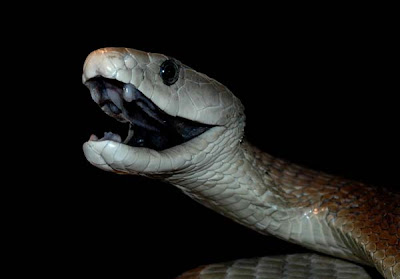The Life of Animals | Black Mamba | snake in Africa, averaging around 2.5 meters (8.2 ft), and Sometimes growing up to 4.3 meters (14 ft). The eastern green mamba, Dendroaspis angusticeps, and the black mamba, Dendroaspis polylepis were the resource persons Considered a single species until 1946 Pls Dr. Vivian Fitzsimons Them split into separate species. The snake's scientific name is Dendroaspis polylepis: Dendroaspis meaning "tree asp ', and polylepis meaning" many scaled. " The name "black mamba" is given to the snake not Because of its body color but Because of its ink-black mouth.
The black mamba's back skin color is olive, brownish, gray, or khaki Sometimes the adult snake's length is on average 2.5 meters (8.2 ft) but some specimens have reached lengths of 4.3 to 4.5 meters (14 to 15 ft). Black mambas weigh about 1.6 kilograms (3.5 lb) on average. The black mamba lives in Africa, occupying the following range: Northeast Democratic Republic of the Congo, Southwestern Sudan to Ethiopia, Eritrea, Somalia, Kenya, Eastern Uganda, Tanzania, southwards to Mozambique, Swaziland, Malawi, Zambia, Zimbabwe and Botswana to KwaZulu -Natal in South Africa, and Namibia; then northeasterly through Angola to the Southeastern Zaire The black mamba is not commonly found above altitudes of 1000 meters (3280.8 feet), although the distribution of the black mamba does reach 1800 meters (5905.5 feet) in Kenya and 1650 meters (5413.3 feet) in Zambia. The black mamba has adapted to a variety of climates ranging from savanna, woodlands, rocky slopes, dense forests and even humid swamps of The Grassland and savanna Woodland / shrubs That extends through the central, eastern and southern Africa are the black mamba's typical habitat of the black mamba prefers more arid environments Woodland Such as light, rocky outcrops, dry and semi-arid bush country.
The black mamba uses its speed to escape threats, not to hunt prey. The venom of the black mamba Mainly consists of potent neurotoxins. With a LD50 of 12:25 mg/kg-0.32 mg / kg, the black mamba's venom is virulently toxic. Although only 10 to 15 mg is deadly to a human adult, its bite delivers about 100-120 mg of venom on average but They can deliver up to 400 mg of venom in a single bite Potentially Black mamba bites can kill a human within 20 hours or less Depending on the nature of the bite and the area Bitten, but Death Occurs usually after 30-60 minutes on average, Sometimes even taking up to three hours. Presently, there is a polyvalent antivenom produced by SAIMR (South African Institute for Medical Research) to treat all black mamba bites from different localities.
When warding off a threat, the black mamba delivers multiple strikes, injecting large amounts of virulently toxic venom with each strike, landing Often bites on the body or head, unlike other snakes. Also, the black mamba's venom has been known to cause paralysis. Many herpetologists, including South African-born herpetologist Austin Stevens, the black mamba regard as one of, if not the most dangerous and feared snakes in the world due to Various factors including the toxicity and high yield of its venom, its high level of aggression , it's speed, agility, size, and other factors. Mongooses are the main predators of the black mamba. They usually prey on young snakes and eggs. Mongooses are notable for Their resistance to snake toxins. Cape file snakes are also predators of young black mambas.













